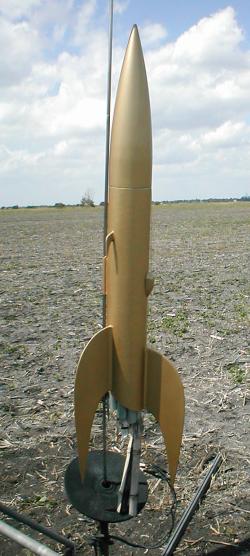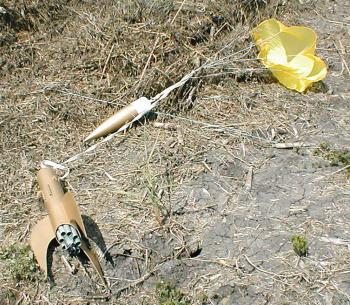Pemberton Technologies Bucky Jones Space Cadet
Pemberton Technologies - Bucky Jones Space Cadet {Kit}
Contributed by James Gartrell
| Construction Rating: | starstarstarstarstar |
| Flight Rating: | starstarstarstarstar |
| Overall Rating: | starstarstarstarstar |
| Manufacturer: | Pemberton Technologies  |
Brief:
Layne Pemberton contacted me, after a recommendation from Don Magness of
Squirrel Works Model Rockets, to beta test his "Bucky" rocket. Well,
what could I say but, "Heck yeah!" This is the first release of three
very nice looking rockets upcoming in the growing fleet of rockets available
from PemTech. If you're looking for something a little different, forget it.
This kit, like all of the kits from Pemberton Technologies, is a lot different!
Layne has done a superb job of capturing the magic of Sci-Fi in this 3"
diameter 29mm rocket, and it is provided at a very reasonable price.

Construction:
The kit includes:
- 3" LOC kraft angle-cut tube
- 8 18mm exhaust tubes
- 3 1/8" ply TTW pre-cut fins
- 2 1/8" basswood "probes"
- 2 3" to 1.1" ply centering rings
- 7.5" 29mm motor mount tube
- wire motor retainer
- 11" LOC nose cone
- 10 nose ballast weights (105 grams total)
- 8' 9/16" nylon/Kevlar® shock cord
- 1/4" kraft launch lug
As noted when you visit Layne's website, you should be prepared to "build" your rocket. While that's true, the main fins and body tube are cut for you, so there isn't anything I would consider extremely difficult - tedious, maybe, but not really that difficult. Regardless of the "no frills" nature of the kit, I was impressed, overall, with parts quality. Most of all, though, I was impressed with how all the parts came together creating a beautiful rocket.
The kit arrived with the parts packed in the shipping box. Again, no frills here, however, the included CD was a nice touch. Besides the printed instructions, the CD has the instructions in both pdf and Word files, the RockSim file with a link to Apogee's site to download the trial version, plus a lot more. The CD is useful for a couple of very practical reasons. First, if you get a little wild with the CA and glue a couple pages together, you can reprint the particular page. Second, after building my rocket I weighed it and measured out the CG, then modified the RockSim file to include the specifics of my build to get a better idea of how my rocket would perform. Now that's nice!
The instructions are well laid out with numbered "destructions" (Layne's well-practiced humor is interlaced here and throughout the instructions) and fully illustrated, so you get lots of help when doing things like "creating" a cockpit from a block of balsa. The instructions for shaping the cockpit are very detailed. Following them, I was able to get something close to what's pictured, but it still displayed my own individuality. Pretty cool, really.
The most difficult step for me was cutting out the tiny forward "probes" from a small slab of 1/8" basswood. Cutting the curves on something that small takes some patience. I cut them a little larger than marked and then used 100-grit sandpaper to bring it in to the mark. The exhaust tubes also had to be cut from longer tubes. There wasn't any leftover tube, so mark the exhaust tube cuts first before actually cutting them out. The wire hanger used for motor retention blends well into the exhaust tubes and is a nice solution for positive motor retention in this unique design.
A Dremel is a nice tool to use for cutting the fin slots in the tube. If you don't have one, they're a worthwhile investment for this step plus a lot of other rocket-building activities. Installation of the motor mount, fins and forward centering ring is pretty standard, except rather than filling the fin cavity with expanding foam, as suggested, I borrowed a technique from Don Magness and cut six 1/4" dowels just shy of the length of the fin tabs and tacked them in with CA on either side of each tab against the tube wall and then filleted the fins, motor mount and forward centering ring.
After installing the rear centering ring and exhaust tubes, I made two other modifications to the kit. I installed an eyebolt in the nose cone, and rather than using the provided Kevlar® for the shock cord attachment, I used a heavier grade for an extra safety measure. The shock cord was long and sturdy 9/16" tubular nylon/Kevlar®. Very nice!
I cut the kraft launch lug in half and used J-B Weld to anchor them. The side-by-side arrangement of the lugs creates the illusion of a couple of cannons underneath the cockpit, another very nice design feature.
A bright yellow 30" nylon parachute with nylon shrouds is provided to bring Bucky safely back to the ground. The lines were epoxied to the nylon and lightly tacked in, so I had a friend sew over them again for extra security. To protect the fins on recovery, a length of Kevlar® is also attached through a small hole in the dorsal fin and attached to a loop in the shock cord to bring the rocket down flat.
 Finishing:
Finishing:
Finishing the rocket was a lot easier considering the quality of the main tube.
It is really nice. So nice, I didn't even attempt to fill the lines. You have
to get really close to see them. After filleting the fins with epoxy and
sanding everything with 220-grit, I completed final sanding with 400-grit. Then
sprayed on an undercoat of Kilz to seal off the epoxy and sanded with 320-grit.
Sprayed on a coat of Krylon primer and then spot sanded, sprayed another coat
of Krylon primer and then sanded with 400-grit. Masked off the fins and body
and painted the exhaust tubes and motor tube with DupliColor millennium silver.
After the back end dried, I covered it with tin foil and applied the first coat
of Rustoleum gold to the rest of the rocket. After that dried, I sanded with
600-grit and then applied the final coat of gold. There are no decals to apply,
so next I applied a couple of coats of Future floor wax to protect the finish
and improve the shine. Tada!
Construction Rating: 5 out of 5
Flight:
After what seemed an eternity, finally, the day for Bucky to fly arrived. He
would be flying from the DARS Windom field, a huge plowed field that often
sports flights to 16,000 feet or more. Skies were partly cloudy but the ceiling
was well above Bucky's intended altitude. Unfortunately, the wind was blowing
between 15-20mph with occasional let-up to maybe 7-12mph. Not the best
conditions for a flight, considering Bucky's large fins. However, the ground
was soft, which was great for landing in high winds. This also provided an
advantage due to the horizontal recovery method Layne engineered for Bucky.
A buddy of mine was planning to come with me to watch over the assembly of my first reload motor, but he had to work. So, rather than use the reload motors I had, I went down to Bob Korman's area to pick up a couple of his single use Roadrunner motors. His F60 motor looked like a good choice, but the only available delays were 4 and 7 seconds. Two of the recommended motors were the Aerotech F52-5 and G64-7. Hmm. What to use? Considering the wind, I opted to use the 4-second delay. The lip on the back of the motor fit the motor retainer perfectly, but for extra security I taped the motor retainer to the motor tube. After prepping (PemTech included plenty of cellulose wadding), Bucky and I headed to the launch pad.
Sliding Bucky over the ¼" launch rod, I noticed I needed something to hold Bucky up further from the bottom of the pad. So, I found a corn stalk that was used to prop the rocket up about eight inches above the pad. Great! Igniter was hooked up (Roadrunner motors come with a very nice igniter), pad was tested and armed, and Bucky was ready for flight.
Naturally, Bucky had gained everyone's attention so most everyone was waiting for the launch. Bucky is holding firmly to the launch rod and ready to go. He looks confident, majestic and very cool. Launch was truly spectacular and really wowed the crowd. Despite the wind, Bucky jumped off the pad with authority and climbed arrow-straight into the air. With no twists or even the slightest turn, it was a beautiful flight. I could hear the oohs and aahs of the crowd as the rocket began to coast upwards.

Recovery:
The chute popped just before the top, but it had slowed down enough that the
chute deployed without problem. Gracefully, Bucky returned to Earth in
horizontal fashion. The chute is perfect for this rocket. With the parachute
leading the rocket, it landed on the rounded edge of the fins and then dipped
the front of the body tube into the ground. I had strengthened the front of the
tube with CA, so no problem with that, and with the firm grip on the dirt the
parachute couldn't drag the rocket (several others had problems with that
during the day because of the high winds). Recovering in perfect shape I had
planned to fly Bucky again the next day, but it rained. Great flight, though,
with a great rocket! Stay tuned for the further adventures of Bucky Jones -
Space Cadet!
Flight Rating: 5 out of 5
Summary:
This was my first time to build a rocket to fly on anything bigger than an
Aerotech E-motor. I found the instructions very easy to follow and logically
arranged. Bucky is a nice rocket to build if you want to make the transition
from model rockets to mid-power with some flair. It's a very cool rocket!
Pros:
Great design, quality parts, excellent instructions, and a nice long shock cord
Cons:
NC/Shock cord attachment - I like this to be solid. The recovery of your rocket is dependent upon that holding together.
Overall Rating: 5 out of 5
 |
 |
Flights
 |
 |
 |
 |
J.L. (September 21, 2006)